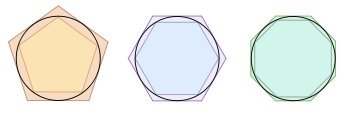
Back نهاية متتالية Arabic Llende d'una socesión AST Эҙмә-эҙлелектең сикләнмәһе Bashkir Ліміт паслядоўнасці Byelorussian Граница на редица Bulgarian ক্রম সীমা Bengali/Bangla Granična vrijednost niza BS Convergència (successió matemàtica) Catalan Limita posloupnosti Czech Умлăн-хыçлăнлăх чикки CV
This article needs additional citations for verification. (May 2017) |

| 1 | 0.841471 |
| 2 | 0.958851 |
| ... | |
| 10 | 0.998334 |
| ... | |
| 100 | 0.999983 |
As the positive integer becomes larger and larger, the value becomes arbitrarily close to . We say that "the limit of the sequence equals ."
In mathematics, the limit of a sequence is the value that the terms of a sequence "tend to", and is often denoted using the symbol (e.g., ).[1] If such a limit exists and is finite, the sequence is called convergent.[2] A sequence that does not converge is said to be divergent.[3] The limit of a sequence is said to be the fundamental notion on which the whole of mathematical analysis ultimately rests.[1]
Limits can be defined in any metric or topological space, but are usually first encountered in the real numbers.
- ^ a b Courant (1961), p. 29.
- ^ Weisstein, Eric W. "Convergent Sequence". mathworld.wolfram.com. Retrieved 2020-08-18.
- ^ Courant (1961), p. 39.







